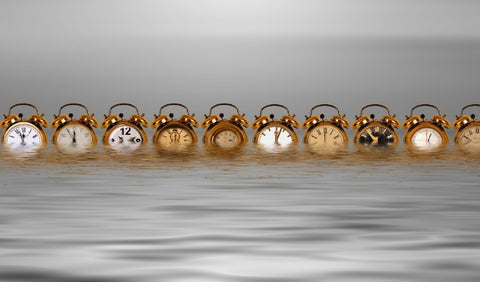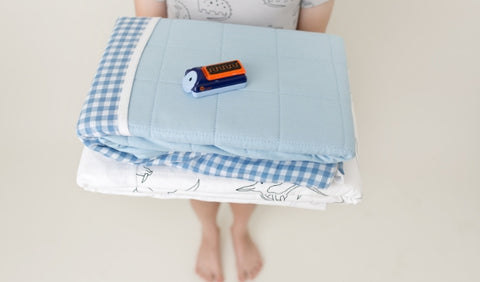Many kids, even teenagers can struggle with night time bed wetting. Bed Wetting Alarms can help your child get dry at night.
How do Bed Wetting Alarms Work?
CONDITIONED LEARNING
Bedwetting Alarms work on the principle of Conditioned Learning. This principle was discovered by Pavlov, a Russian psychologist in the early 1900s.
He found that if a powerful stimulus is associated with a neutral one then after a time the neutral one acquires the same strength as the powerful one. In his work with dogs Pavlov found that putting food in a dog’s mouth was a powerful stimulus triggering the production of saliva. He then experimented with ringing a bell each time he gave the dog some food and after a time he found that simply ringing a bell would result in the dog producing saliva.
People are also affected by this kind of learning and mostly we are completely unaware that it is happening. Whenever a powerful and neutral stimulus occur together a link is made.
In the case of a bed wetter, the sensation of a full bladder should trigger awaking but it doesn’t. However, the sounds of a loud noise can trigger waking and cause an immediate contraction of the external sphincter muscle which stops the flow of urine from the bladder.

If a powerful stimulus (alarm) is associated with a neutral one (wetting the bed) then after a time the neutral one requires the same strength as the powerful one.
The solution is to pair up the feeling of a full bladder with a loud noise so that, in time, the sensation of a full bladder will do the waking just like a loud noise.
Alarms work by placing a sensor in the child’s underwear that sounds an alarm when a small amount of urine is released, waking the child up. Over time the child gradually learns to associate the sensation of a full bladder with the need to awaken.
How long will it take?
From a few weeks to a few months. Some bed wetter’s, who are particularly deep sleepers, may take longer and require more encouragement and help from parents to make sure they wake in response to the alarm. (Read one parents story at the end of this article).
Brolly Sheets has free downloadable progress charts.
The difference between wired and wireless alarms
Like many other types of technology, alarms come both wired and wireless. They do the same job, the difference is in ease of use and price.
Wired alarms are a lower price and have a wire (85 cm) connecting the sensor in your child's underwear to the base on the bed side table.
Wireless alarms are just that. The sensor and unit are not connected and like most wireless technology, this comes at a higher cost

What else do I need?
Your child is not going to be dry overnight, it takes time. So there will be accidents. Prepare the bed with a Brolly Sheet to make it easy to change the wet bed in the night. Plus sanitary pads. Mini pads make it very easy to place the sensor in your child's pyjamas. Just cut a slit and slide in the sensor. Then stick the pad into the crotch of your child's underwear / pjs, making sure the sensor is near where the wee will be passed. Boys and girls will have different placement areas.
Still the old bulky alarms of the past?
"As a bed wetter for many years, I was terrified of the "big buzzer" my parents bought. 40 years later, this tiny, discreet unit from Brolly Sheets has been a huge success. My 5.5 yo son, who needed 3 nappies at night, is now leaping out of bed at the right time, and not a drop gets on his sheets. We love it! Soon he plans to do some sleepovers at friends’ houses. We're all delighted! "
FAQs
Will I need to get up?
Yes. Support may initially involve ensuring your child responds to the alarm in the night by going to the toilet and preparing the Urosensor™ for immediate re-use. Encouragement will involve praise for any and all progress made towards the child’s goal of ending his or her bedwetting.
How loud are they?
DRI Sleeper® alarms are designed to wake children rather than provide audio entertainment or ineffective, battery consuming, alternatives to sound such as vibration or flashing lights. The Urosensors™ respond to small amounts of urine by emitting a loud alarm around 95dB at 3.3 kHz, a frequency that has been established as one to which the human ear is especially sensitive.
Are they safe?
Dri Sleeper alarms are New Zealand made. Independently assessed and certified annually by SAI Global as meeting the internationally recognized standards for design and manufacture of medical devices.
How successful are they?
DRI Sleeper® alarms have been curing bedwetting since 1979 and have up to an 80% success rate according to independently audited annual surveys

A customer’s experience
My 7 year old son has NEVER been dry in his life. Every night he was SATURATED and leaked through pull ups through the bedding.
It was his decision to order his alarm as he was desperate to be dry and 'normal'. We ordered the DRI Sleeper Excel alarm.
Week 1-2
Absolute hell. It was like having a newborn again. Up 3-4 times a night, racing to the toilet with a boy who was in a deep sleep. By the second week our boy was carefully cutting into sanitary pads (for his alarm), all lined up ready for the night ahead. He took full control of his treatment but we were exhausted. Twice we turned the device off overnight (without his knowledge) just to get some much needed sleep.
He didn't remember many times despite using a cold cloth on his face and turning the lights on. By the second week I was over it. No improvement. I broke down at work ....but was encouraged by a colleague who told me to keep going for at least 4 weeks. It felt like forever but we kept going.
Week 3-4
Only twice a night! I couldn't believe it. But still hard work. I was doubtful it would ever work. Then, out of the blue, he had a dry night!! Fluke? One off??? Then....
Week 5 - DRY!
Week 6 - DRY!
and so on and so on and so on!!!
From the first night he was dry he has NEVER had an accident since. He raced around the house with joy, saying 'my brain has woken up, my brain has woken up!!!!". It's now 6 weeks since his first dry night.
He is the happiest and proudest kid on earth. I'm still pinching myself that it worked. In reflection I wish I'd gotten the wireless version but it still did a great job.
Words can't express how this has changed our sons life and ours. We have given away all his pull ups and we are all well slept. I can't thank you enough. - Debbi, Australia
Testimonials
“We bought the wireless sensor (just tuck the wetness sensor into the nappy) and it worked! Our 5.5 year old was a very heavy wetter (needed a disposable AND thick bamboo cloth nappy at night). We used the sensor and within 2 months he was dry. So we've lent the gadget to a friend for her son. It's magic!”
“Best thing I ever did! Daughter was ready to stop wetting bed. She just couldn't wake up! I put the sensor in the gusset of her knickers instead of mini pads! It was super sensitive! 3 nights and we have been dry over a fortnight!”
Check out some of the many product reviews we have online to get the good and the not so good stories straight from other parents.
